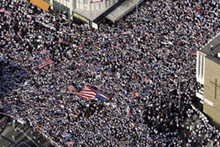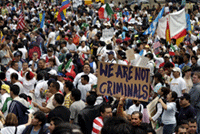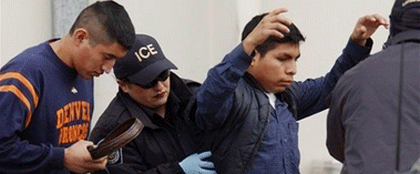Posted April 21, 2007
The second annual May Day mobilizations for immigrant rights brought an outpouring of 100,000 people into the streets of Chicago; tens of thousands in Los Angeles, where peaceful marchers with their families, as well as journalists, were met with a police riot at MacArthur Park; five thousand or more in Detroit; and thousands or tens of thousands in many other cities.
While this year’s protests couldn’t match the gigantic turnouts of 2006 – partly because this year there isn’t the “Sensenbrenner Bill” in Congress that enraged immigrant communities, partly because Los Angeles mayor Villaraigosa threatened punishment for student walkouts, and for a variety of specific local reasons – nonetheless these marches have confirmed that May Day is back.
This workers’ holiday began in nineteenth century America as a demand for decent pay and conditions, spearheaded by immigrant workers. Today’s immigrant rights movement has reclaimed it as a day to demand full legal status for all, and end of the brutal Immigration and Customs Enforcement (ICE) raids and deportations that are tearing families apart, and a rapid path to U.S. citizenship for those who desire it.

Last spring, in response to punitive legislation proposed in Congress and increased repression of immigrant workers, millions of predominantly working-class Latina/o immigrants took to the streets across the United States. Support and organization was broad: the Catholic Church, local hometown associations, unions and worker centers, and local Latina/o media played major roles in mobilizing for the actions. Immigrants from other countries have turned out to march in various cities.
The result: the largest series of demonstrations in U.S. history and, in many areas, what amounted to one-day strikes. In Los Angeles, the garment and port trucking industries were nearly paralyzed. In the Midwest, the meatpacking industry was shut down.

In New York, over 10,000 businesses closed (mostly small delis and ethnic businesses). Investment bankers on Wall Street were heard saying “let them [Mexicans] in so that we can get some coffee.” Many employers responded by firing or disciplining workers; others supported workers’ efforts and a new immigration reform policy.
The movement sparked a lively debate in the media about immigration, with politicians scrambling to pass an immigration reform bill. The bi-partisan Comprehensive Immigration Reform Act of 2006 passed the Senate a short two months after the bill that sparked the wave of street demonstrations – Jim Sensenbrenner’s HR 4437 – passed the House. The Senate bill created substantial debate and division in segments of the immigrant rights movement. Many immigrant workers, religious organizations, unions, and politicians supported the bill. The movement’s left wing opposed it.
Among its most controversial elements, the Senate bill included a divisive, 3-tier path to legalization (which many undocumented immigrants could not utilize), an expanded guest worker program, instant verification (an extension of the Social Security “No Match” Program), and increased border enforcement (see resources below for a more detailed analysis). Ultimately the Senate bill failed to pass the House and the hope of comprehensive immigration reform was essentially “off the table.”
The Border Fence Bill, passed by Congress last year, further militarizes the border and creates an even more repressive and coercive environment for immigrants.
On the ground, last year’s immigrant rights demonstrations have provoked unprecedented Immigration and Customs Enforcement (ICE, the new INS) raids. According to an ICE spokesperson, there have been over 18,000 arrests so far, mostly people in their homes. These raids have targeted workers in the meatpacking industry, construction, cleaning services, and especially those firms where workers are fighting for their rights or organizing unions.

The left wing of the movement responded to these repressive tactics by holding a strategizing conference in August 2006 in Chicago, and organizing marches for Labor Day of that year. At the August meeting the 10 points of unity were:
- Immediate unconditional legalization for all undocumented currently in the United States
- No mass deportations
- No arbitrary, mass or indefinite detentions
- No employer sanctions
- No guest-worker programs
- Full labor rights, civil rights, and civil liberties
- No militarization of the border
- No border wall
- No criminalization of workers
- Increase of family reunification visas
These actions and this movement – like the civil rights struggles in the “long decade” of the 1960s – are key to breaking down racial and economic barriers in the U.S. and forging bigger struggles for social justice.
